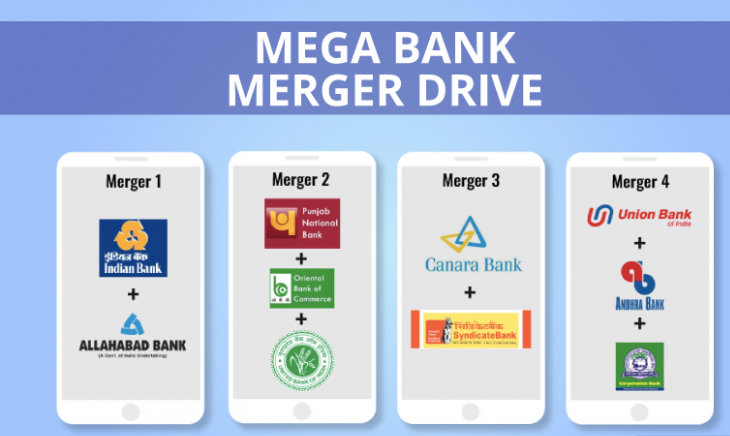Some of the branches may be closed resulting in disruption of locker facilities, as also some of the ATM outlets being reshuffled etc. Customers must take some steps after or before their bank merger takes place.
The finance minister announced a spate of bank mergers. This consolidation will bring down the total number of public sector banks (PSBs) in the country to 12 from 27. State Bank of India (SBI) had merged five of its associate banks into itself. Then there was the merger of three PSBs – Bank of Baroda, Dena Bank and Vijaya Bank last year.
While the positives for the banks from these mergers is widely discussed, what must you as a customer be aware of so that you can continue banking smoothly if you held an account with any of these PSBs.
Steps To Be Taken To Secure Your Banking Experience for Bank Merger:

Don’t panic, your money is safe:
All stakeholders need to understand the context of a merger first. It is in the interest of the customers, the banks and the economy of the country. There is no reason to panic. When banks merge, sufficient care is taken to ensure that the impact on customers is minimal.
As the boards of individual banks approve the mergers, there will be official announcements and procedures communicated by your bank through emails/letters for the transition of savings/current accounts, locker facilities, fixed deposits, loan accounts, etc. with the new bank (merged entity). Around the time of such merger announcements, there are possibilities of fraud emails being circulated; so stay alert and don’t share your account details, internet banking ID and pin, etc. to any unknown/phishing emails.
Get your updated account details:
The bank mergers announced will set several changes in motion that you will have to be prepared for in the near term. Adhil Shetty, CEO of BankBazaar says, “To start with, your account number and customer IDs, as well as the associated IFSC codes may change. If you have accounts with more than one bank, especially the merging banks, then the two accounts may be allotted a single customer ID.” So, while you may not need to redo your know-your-customer (KYC) exercise, do make sure your email ID and mobile number are updated with the bank so that you receive all official intimations on the allotment of new accounts instantly.
Eventually, new account numbers, customer IDs, and IFSC codes mean that you would have to update these details with various third-party entities including the income tax department for tax refunds, insurers to get maturity proceeds, mutual funds to get the redemption amounts, etc. You will have to submit fresh mandate forms of auto-debits for mutual fund investments and loan equated monthly instalments (EMIs). It’s recommended that you make a list of all the financial accounts you hold, including loans, insurance policies, mutual funds, etc. so that you do not miss out on updating them when the time comes for the bank merger.
Internet banking facility may differ:
While transitioning, the individual online banking portals of the merging banks may cease to exist and you may be redirected to the merged entity’s portal. However, depending on the new bank’s policies, you may be able to continue using your older credentials (user ID and password) for online banking.
Anil Rego, CEO and Founder of financial advisory firm Right Horizons cautions, “Stay alert while redirecting to the new website and confirm you are login to correct bank website for internet banking and not on phishing webpage which may look similar to new bank homepage.”
Learn about branches and ATMs that may be rationalised:
There may also be a certain amount of branch rationalisation, as more than one merging entity may have branches in the vicinity. So, some of the branches may be closed resulting in disruption of locker facilities, as also some of the ATM outlets being reshuffled etc. You should closely watch the communication received from the banks in this regard.
Existing debit and credit cards will continue to be valid until notified by the bank. On the brighter side, customers will be able to access ATMs of all the merging banks for free for cash withdrawals, balance inquiry, etc. New cards will be issued by the merged bank.
Know the services and charges of the merged entity:
After the merger of the banks is complete, it’s advised to know the new bank’s (merged entity’s) free and chargeable services, interest rates for deposit and borrowing, etc.
The rates of banking services like maintenance of minimum balance or average quarterly balance will be left unchanged for some time at the new bank. However, eventually, these may be charged as per the acquiring bank’s rules and regulations.
Interest rates on your existing loans and fixed deposits will not change post the merger unless renewed. It will only be transferred to the merged bank. However, all retail loans will be linked to external benchmarks from October 1, so the new bank will give you the option of shifting to the new interest rate regime on renewal. But, if you opt to continue with the marginal cost of funds based lending rate (MCLR), the loan will be linked to the new bank’s rates upon reset.












Hello. And Bye.